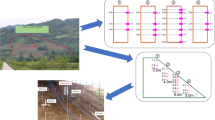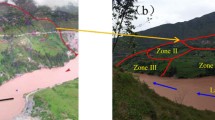Abstract
In order to improve the understanding of the fundamental mechanism of rainfall infiltration induced landslides in accumulation slope and to clarify some important characteristics of slope performance, artificial rainfall simulation tests and field synthetic monitoring were carried out on a typical accumulation slope of Shangrui Freeway in Guizhou Province, China. The monitoring results show that the most accumulation landslides caused by rainfall infiltration are shallow relaxation failure, whose deformation zone lies within the top 0–4 m soil layer. The deformation of slope gradually reduces from the surface, where the greatest deformation lies in, to the deep part of slope. The average percentage of infiltration during the first 2 h is 86%, and then it reduces gradually with time because of the increase of the surface runoff. The average percentage of infiltration drop to a relatively stable value (50%) after 6 h. Rainfall infiltration causes obvious increase of pore-water pressure, which may result in a reduction of shear strength due to a decrease in effective stress and wetting-induced softening. The double-effect of rainfall infiltration is the main reason of rainfall infiltration induced landslides in accumulation slope.
Similar content being viewed by others
References
ZHOU Zhong, FU He-lin, LIU Bao-chen, TAN Han-hua, LUO Qiang, LONG Wan-xue. Scheme design of field simulation test of accumulation landslide [J]. Journal of Highway, 2006(1): 74–79. (in Chinese)
ZHOU Zhong. Study on the fluid-solid coupling characteristic of soil and rock blending landslide and its prediction and forecast [D]. Changsha: Central South University, 2006. (in Chinese)
ZHOU Zhong, FU He-lin, LIU Bao-chen, TAN Han-hua, LONG Wan-xue, LUO Qiang. Study on in-situ monitoring of cut tests on a well-instrumented colluvial slope [J]. Journal of Rock Mechanics and Engineering, 2006, 25(10): 2065–2070. (in Chinese)
LI Ai-guo, YUE Zhong-qi, TAN Guo-huan, LEE Zhuo-fen, LUO Jin-tan. Design and installation of comprehensive instrumentation system for slope in Hong Kong [J]. Journal of Rock Mechanics and Engineering, 2003, 22(5): 790–796. (in Chinese)
AU S W. Rain-induced slope instability in Hong Kong [J]. Q J Engng Geol, 1998, 51(1): 1–36.
YANG Xiao-li, SUI Zhi-rong. Seismic failure mechanisms for loaded slopes with associated and nonassociated flow rules [J]. Journal of Central South University of Technology, 2008, 15(2): 276–279.
KEEFER D K, WILSON R C, MARK R K, BRABB E E, BROWN III W M, ELLEN S D, HARP E L, WIECZOREK G F, ALGER C S, ZATKIN R S. Real-time landslide warning during heavy rainfall [J]. Science, 1987, 238: 921–925.
FINLAY P J, FELL R, MAGUIRE P K. The relationship between the probability of landslide occurrence and rainfall [J]. Canadian Geotechnical Journal, 1997, 34: 811–824.
ZHAN Lang-tong, WU Hong-wei, BAO Cheng-gang, GONG Bi-wei. Artificial rainfall infiltration tests on a well-instrumented unsaturated expansive soil slope [J]. Rock and Soil Mechanics, 2003, 24(2): 151–158. (in Chinese)
LAN Heng-xing, WU Fa-quan, ZHOU Cheng-hu, WANG Ling-juan. Spatial hazard analysis and prediction on rainfall-induced landslide using GIS [J]. Chinese Science Bulletin, 2003, 48(7): 703–708.
DAI F C, LEE C F. Frequency-volume relation and prediction of rainfall-induced landslides [J]. Engineering Geology, 2001, 59(3/4): 253–266.
YANG Xiao-li, YIN Jian-hua. Slope stability analysis with nonlinear failure criterion [J]. Journal of Engineering Mechanics, 2004, 130(3): 267–273.
YANG Xiao-li, LI Liang, YIN Jian-hua. Seismic and stability analysis for rock slopes by a kinematical approach [J]. Geotechnique, 2004, 54(8): 543–549.
CROSTA G. Regionalization of rainfall thresholds: An aid to landslide hazard evaluation [J]. Environmental Geology, 1998, 35(2/3): 131–145.
LIN M L, JENG F S. Characteristics of hazards induced by extremely heavy rainfall in central Taiwan-typhoon herb [J]. Engineering Geology, 2000, 58(2): 191–207.
CHEN Wen-liang, TANG Ke-li. A new SR style field artificial rainfall simulator [J]. Research of Soil and Water Conservation, 2000, 7(4): 106–110. (in Chinese)
Author information
Authors and Affiliations
Corresponding author
Additional information
Foundation item: Project(50678175) supported by the National Natural Science Foundation of China
Rights and permissions
About this article
Cite this article
Zhou, Z., Wang, Hg., Fu, Hl. et al. Influences of rainfall infiltration on stability of accumulation slope by in-situ monitoring test. J. Cent. South Univ. Technol. 16, 297–302 (2009). https://doi.org/10.1007/s11771-009-0051-1
Received:
Accepted:
Published:
Issue Date:
DOI: https://doi.org/10.1007/s11771-009-0051-1




